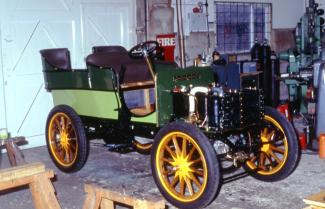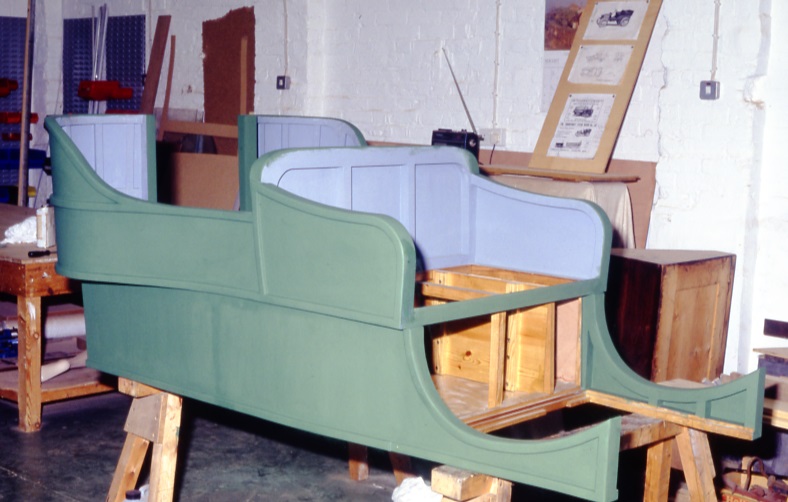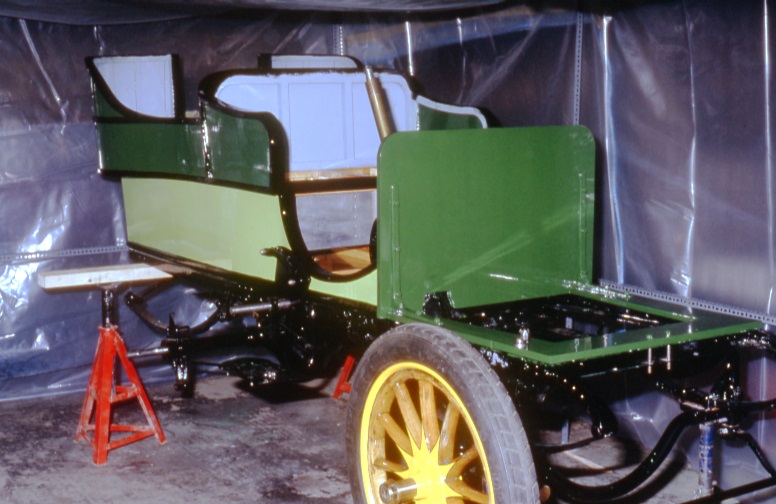
The Thornycroft 10hp car was completely rebuilt in 1994, and restored to its 1903 condition as far as possible. The entire two-seat bodywork was removed and replaced by an open four-seater tonneau body, for which a complete framework was constructed, using a contemporary photograph and sketches from the Thornycroft archive collections. The frame is in ash, as are the scuttle and bonnet boards, and the panelling is made from laminated hardwoods. The only original body parts remaining were the wings and bonnet. The rear wings had been cut off short, and these were restored to their original length and re-bracketed. The upholstery, flooring and tonneau covers were made by David Strange of Guildford, and the vehicle was painted in contemporary colours by hand with coach finish from Horace & Williams of Burgess Hill.
The twin-cylinder AZ engine had suffered considerable frost damage, and many earlier cracks had been repaired by brazing. Instead of its normal cast-iron pistons, the engine had been fitted with home-made steel pistons which had badly damaged the cylinder bores. The cylinder block was re-sleeved after extensive welding repairs, and new pistons were made by James & Harmer of Poole. The camshaft and bearings were replaced; however, the cams, being separate as in marine engine practice, were re-used as they were relatively unworn. The crankshaft bearings were in usable condition, and only a new thrust bearing was required - made in bronze to match the original. The timing gears (on the crank and camshafts) had been replaced by standard pitch gears, but the water pump drive gear was original and was out of pitch with the others. A new gear was cut to match, and a new shaft and bearings were made. The water pump was fitted with a new packing sleeve and packing.
New exhaust valves were made, as were new springs and retainers for the automatic inlet valves which are situated under the inlet manifold. A new exhaust manifold was constructed, as well as piping and a silencer from contemporary photographs. The carburettor spindle was re-bushed, and a new hot air pipe made up. Ignition is by trembler coils, and these were replaced with new items from Independent Ignition Services of Barnstaple. The distributor was rebuilt with new insulators.
Clutch was generally serviceable, and new pivot pins and withdrawal bushes were made for it. However, the gearbox was a disaster, all moving gears being wrecked. New ones were cut, the shafts re-ground (by Saunders of Cadnam) and all new bronze bearings made and fitted. A completely new drive shaft was made to the pattern of the original, which was badly twisted and bent.
The rear axle required a new crown wheel and pinion, made by Classic Motor Gears, of Fordingbridge, and new half shafts, bearings and pinion bushes were made. All brake gear was fitted new pins and bushes, and linings were made for the rear wheel brakes by the Ferodo company, via Kimbers of Southampton. The rear wheel brakes also required all operating links to be replaced, as some parts were missing or damaged.
The car did not come with the original dynamo, so a drive pulley was made up and fitted to a standard 6 volt Lucas C39 unit, and an RB106 regulator was fitted beneath the driving seat. These can be replaced easily should an original dynamo ever be found.
The radiator was completely rebuilt, as were the water and petrol tanks using the originals as patterns, by J Withers of Arborfield.
A pair of side lamps was bought at the Thruxton sale and a tail lamp from a collector. A suitable bulb horn came from Rushmoor rally and it was subsequently restored by R Holmes. The ignition and charging system was wired in original cotton covered cable from P Beck Vintage Supplies, Norfolk.
The front springs had to be replaced as they were not a pair and one was 1¾ins (44.45mm) longer than its partner, and the rear springs were re-set; work was carried out by Woodhead-Monroe, Eastleigh. The front axle track rod was replaced, the original being bent and damaged beyond safe repair. The tyres were found to be serviceable, but all four tubes were renewed as those fitted tended to leak over a period of time.
The rear axle seized in Winchester on 4 September 1995. It was removed for inspection, and it was found that the key at the diff end of the half shaft had loosened and fouled the star pinions. The resulting swarf blocked the pinion oil way and caused seizure. The damaged star pinions were replaced with new ones made by Classic Motor Gears. New keys were made and fitted with countersunk screws to the half shafts, hopefully to prevent future occurrence. The shafts were re-fitted on 6 October 1995.





